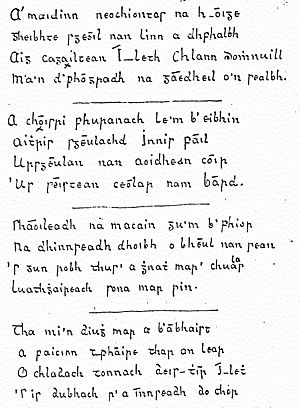William Livingston (poet) facts for kids
Quick facts for kids
William Livingston
|
|
|---|---|
| Native name |
Uilleam Mac Dhunlèibhe
|
| Born | 1808 Gartmain, near Bowmore, Islay, Scotland |
| Died | 1870 |
| Occupation | Poet |
| Language | Scottish Gaelic |
| Nationality | Scottish |
| Notable works | A' maidin neochiontas na h-óige, Vindication of the Celtic Character, Eirinn a' Gul, Fios thun a' Bhàird |
William Livingston (whose Gaelic name was Uilleam Mac Dhunlèibhe) was a Scottish poet. He lived from 1808 to 1870. He came from Bowmore on the island of Islay in Scotland. William Livingston was a very important writer of Scottish Gaelic poems in the 1800s.
Life of William Livingston
William Livingston was born in 1808. His family lived on a farm called Gartmain. This farm was near Bowmore on the island of Islay. This area is part of the Scottish Gàidhealtachd, where Gaelic is spoken.
He loved to learn on his own. Even though he worked as a tailor, he taught himself many languages. These included Latin, Greek, Hebrew, French, and Welsh language. As he traveled around Scotland, he learned a lot. He gathered information about Scotland's places, names, and old stories.
Livingston lived and worked in several places. One of these was Greenock. He later settled in Tradestown, which is in Glasgow.
William Livingston's Writing
William Livingston was a very strong supporter of Scotland. He believed Scotland should be its own nation. He also worked to promote the Gaelic language. He wrote poems about war and long, epic poems.
A scholar named Derick S. Thomson said that Livingston's poems often featured brave Gaels. These are people who speak Gaelic. Thomson noted that some of his longer poems were powerful but sometimes a bit disorganized. He felt that Livingston's epic poems were more like the works of James Macpherson than Homer. However, Livingston's patriotic poems about the Highland Clearances were very strong. One example is Fios thun a' Bhàird.
Livingston was very angry about the Highland Clearances. He saw them as an attack on the Gaelic people. In 1850, he published a book called Vindication of the Celtic Character. This book was a mix of historical stories and strong political opinions.
In 1861, he wrote a poem called Eirinn a' Gul. This means "Ireland Weeping." In this poem, Livingston remembered stories he heard in Islay. These stories were about the Gaelic people of Ireland. He then wrote about the terrible suffering of the Irish people. This suffering was caused by famine and forced removals by landlords. He also sadly mentioned the loss of the old Irish clan leaders. These leaders used to guide their people in war. Livingston felt that later Irish leaders did not have the same heroic qualities. He ended the poem with hope for the future of the Irish people. He wondered where the brave Irish warriors were now.
One of his most famous poems is Fios thun a' Bhàird. This means "A Message to the Bard." This poem strongly criticizes the forced removals on Islay. These removals happened after James Morrison bought the island. The poem describes Islay as a place where people have almost disappeared from the natural world.
You can find examples of William Livingston's work in the Golden Treasury of Scottish Poetry.
Later in his life, Livingston wrote many poems to celebrate his friends. He also wrote about important people in the Glasgow Gaelic community. This included scholars like Eugene O'Curry.
See also
- Poetry of Scotland
- 1808 in poetry
- 1870 in poetry
- 1882 in poetry
- 1808 in Scotland
- 1865 in Scotland
- 1882 in Scotland


